
Human examiners and face recognition systems rely on high quality skin tone presentation. In order to achieve good sample fidelity there shall be no saturation (over- or underexposure) on the skin tone patches of the measurement target. All RGB channels of the image should have at least 7 bits of intensity variation (span a range of at least 128 unique values) in the the test target patch region of the image. This is requiret to get as near to the CIELAB L*a*b* colour space L* level 50, which in turn ensures the wide sRGB gamut availability for the analysis.
While taking pictures of the colour test target and with the calibrated system white balance settings shall be properly set in order to achieve high fidelity skin tones. This is necessary as the digital camera software is preprocessing the internal raw image format and may distort the image colour when JPEG is used for image analysis source format.
According to visible reflectance spectroscopy of human skin when CIELAB L*a*b* colour analysis is used for in vivo ethnic skin characterization is within 5-14 for a* and within 10-24 for b*.

CIE Chroma (a*b*) luminance (L*) levels 50 and 75 show the sRGB gamut compared to the entire a*b* area. Human skin, hair and iris tones are shown with dark rectangles near the neutral point (0,0).
The IEC 61966-8, ANSI IT8.7/2 or similar ISO 12641-1:2016 test chart or other compatible and well documented colour test chart containing skin colour patches should be used to measure noise, colour accuracy, and dynamic range (indirect method).
In order to assure the required image quality system installers shall make quality assurance measurements of light conditions and camera system response when a recommended CIE Standard Illuminant D65 high quality illuminant or similar continuous spectrum daylight illuminant (4500-6000K) and camera including camera control software are used to take pictures. In practice it is also required to reduce the ambient light pollution emanating from uncontrolled daylight sources, fluorescent or similar light sources and reflections from surfaces.
The measurement target colour patch measurement values are transformed from sRGB to CIE XYZ and from XYZ to CIELAB L*a*b* as defined in Coordinate calculation. After calculating the a* and b* coordinates in the CIE 1976 L*a*b* (CIELAB) colour space the Euclidean delta chroma colour difference values are calculated based on these coordinates.
Source: Guiart
Guiart develops methods and software used to create, transmit and manage biometrics, digital imaging material, accompanying text and data records.
Our experts take part in CEN, ICAO and ISO standardization work. |

